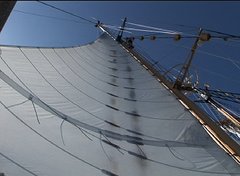May 31, 2007. Palmyra Atoll. Palmyra is the magical stop on our tour. This atoll which is owned by the Nature Conservancy has a working international research station. The intact lagoon, back reef and fore reef offer much to explore and study. We were met at Palmyra by the staff that run the research station, and scientists from Hawaii and California studying the bonefish and black tip sharks. NPR's Alex Chadwick from Radio Expeditions and Stanford News Service reporter Mark Schwartz doing stories on the atoll and the ship.
Once we were briefed on the rules of the road at Palmyra, we were allowed to explore with our skiffs filled with scientific teams. The coral reef team called the Hobo group with Sam Urmy, Johnny Bartz and Jess McNally set out to place Hobos at the various locations in the lagoon, channel and backreef. The predators group (Chris and Del) went out to Penguin Spit (formerly Tigershark point) to do some transects, along with the herbivore algae team (Visran and Kaori). Amy Briggs and Maija Leff also did some algal collections to search for diatoms that collect ciguatera toxin.
Many students and SEA staff wandered around the atoll, a place rich in palm trees, coconuts, and picturesque beaches, including one with a swimming hole complete with a rope swing.
The red-footed booby team sprung into high gear. Karen Lone, Melissa Kunz and I worked with bird researcher Scott Shaffer and graduate student Hillary. We went out every night we were in Palmyra. Wearing long shirts and pants, headlamps and packs, we trudged in rain and clear weather through mud and muck and onto the fore reef areas where the boobies were nesting in low hanging branches of trees.
We noosed the boobies with a long fishing rod that had a monofilament loop. It was challenging in moonlight to slip the noose over the head of the bird. My fishing skills transferred readily to booby catching, and, once a bird was noosed, the gals would swoop in and delicately weigh and tag the birds. The birds were quickly fitted with a GPS tag that was taped to three tail feathers.
We all marveled at holding a booby up close. I was amazed at the head structure -- the colors of the beak and feathers and the sharp serrations on the beak that help this animal catch fish and squid. We sampled some of what they ate, as they often regurgitated their meals and Hilary saved everything for future isotopic studies back at Stanford. We caught about 15 birds in 4 nights work, and instrumented 10.
I’ll forever remember the last night at Palmyra. Working in moonlight, Boris Worm, Sarah Rizk, Adam the first scientist and I tagged three mantas -- huge animals 10 feet or so across. While tagging mantas I had an encounter with a tiger shark that will last as a snapshot in my mind forever. I’ve never seen one so close, and let me tell you, there is little doubt in the water what shark you’re looking at. We sailed through the channel early in the morning on a clear day. It was a nice contrast to the squally rains that had been ever present there. A glorious exit, with mantas swimming beside us. -- Barb Block, chief scientist
Sunday, June 3, 2007
Subscribe to:
Post Comments (Atom)


No comments:
Post a Comment